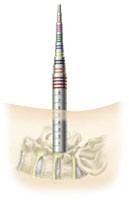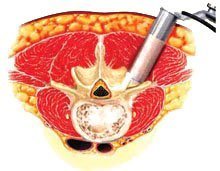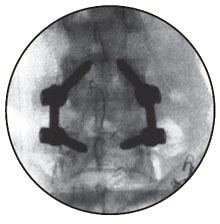What Is A Minimally Invasive TLIF?
Transforaminal lumbar interbody fusion (TLIF) is a form of spine surgery in which the lumbar spine is approached through a number of small incisions in the back. The name of the procedure is derived from: transforaminal (through the foramen), lumbar (lower back), interbody (implants or bone graft placed between two vertebral bodies) and fusion (spinal stabilization).
The TLIF is a variation of the posterior lumbar interbody fusion (PLIF), described in the preceding section.
The main advantage of TLIF is that it may be performed using minimally invasive spine surgery, a treatment that involves small incisions and muscle dilation, allowing the surgeon to gently separate the muscles surrounding the spine rather than cutting them. A minimally invasive approach reduces the trauma to surrounding muscles of the back, and minimizes scarring.
Why Might I Need This Procedure?
A spinal fusion procedure such as a TLIF may be recommended as a surgical treatment option for patients with spinal conditions such as degenerative disc disease, spondylolisthesis or spinal stenosis, which has not responded to conservative treatment measures (rest, physical therapy or medication). The symptoms of lumbar spinal instability may include pain, numbness and/or muscle weakness in the low back, hips and legs.
Dr. Rosenberg will take a number of factors into consideration before recommending a TLIF, including the condition to be treated, your age, health and lifestyle and your anticipated level of activity following surgery.
How Is A Minimally Invasive TLIF Performed?
Spinal Access and Bone Removal
First, your surgeon will make a small incision in the skin of your back over the vertebra(e) to be treated. Depending on the instrumentation to be used, the incision could be as small as approximately 3 centimeters. In a traditional open TLIF, an 8-15 cm incision is typically required.
The muscles surrounding the spine will then be dilated to allow access to the section of spine to be stabilized. After the spine is accessed, the lamina (the “roof” of the vertebra) is removed to allow visualization of the nerve roots. The facet joints, which are directly over the nerve roots, may be trimmed to give the nerve roots more room.
 |
 |
 |
Bone Graft Material Placement
The nerve roots are then moved to one side and the disc material removed from within the centre of the disc.A cage is then inserted into the disc space. The cage preserves the height of the disc space and acts as a bridge, or scaffold, through which new bone can grow. Screws and rods are inserted to stabilize the spine while the treated area heals and fusion occurs, as the ultimate goal of the procedure is to restore spinal stability.
Your surgeon will then close the incision, which typically leaves behind only one or more small scars.
How Long Will It Take Me To Recover?
This minimally invasive procedure typically allows many patients to be discharged within a few days after surgery; however, some patients may require a longer hospital stay. Many patients will notice immediate improvement of some or all of their symptoms; however, other symptoms may improve more gradually.
Dr. Rosenberg will advise you in detail on the post-operative recovery/exercise plan to help you return to your normal activity level as soon as possible. The amount of time that you have to stay in the hospital will depend on this treatment plan. You typically will be up and walking in the hospital by the end of the first or second day after the surgery. You may return to work in 3-6 weeks, depending on how well your body is healing and the type of work/activity level you plan to return to.
Every patient is different, however, and Dr. Rosenberg will determine the appropriate recovery protocol for you. Please note that much of this advice is for your safety, and thus it is important that you follow it to the letter.
